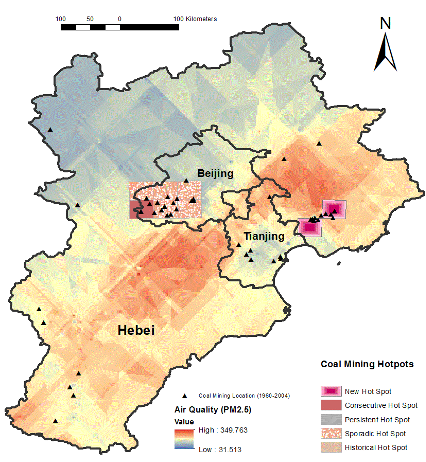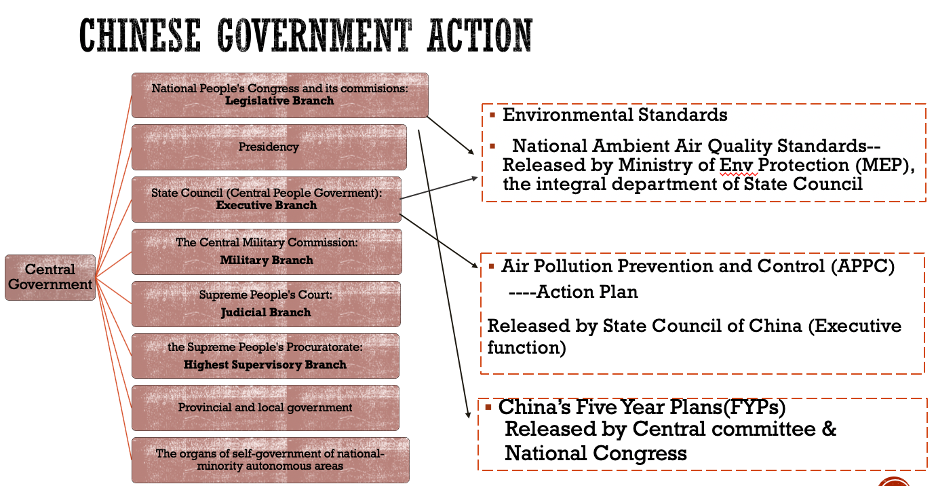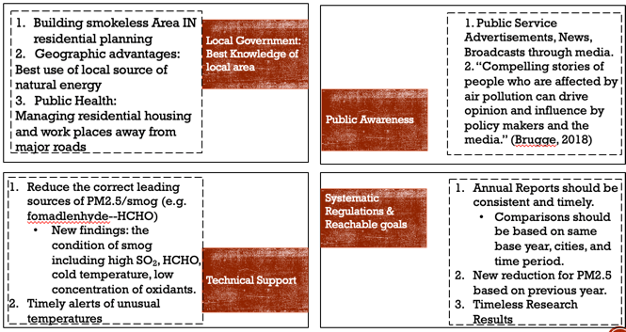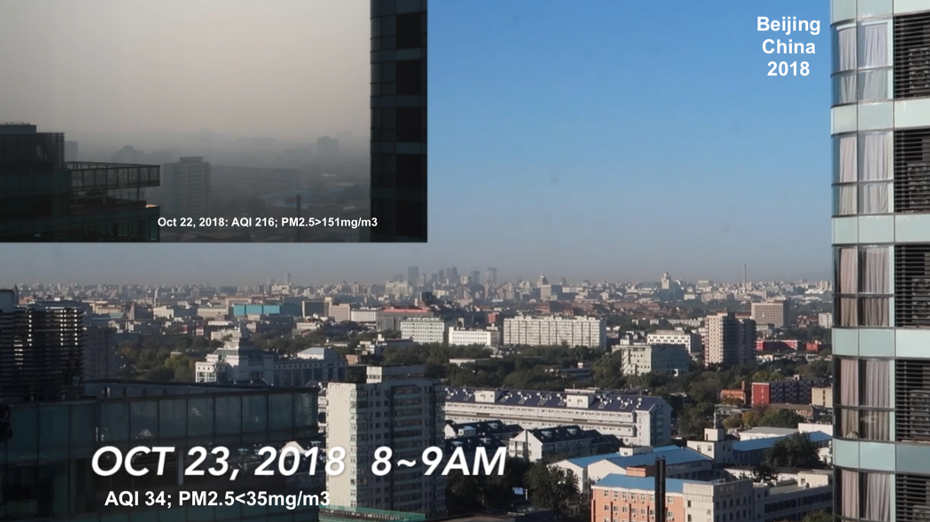This post was adapted from the thesis of recent UEP graduate Minyu Situ (M.A. ’19), who was nominated for the department’s inaugural thesis awards. Her project, under Dr. Sheldon Krimsky, focused on air pollution caused by urban development and its human health effects in China. Minyu conducted studies on two major types of diseases with high mortality due to PM2.5–particulate matter smaller than 2.5 micrometers–pollution, and kept track of the current and increasing historical trends of air pollution and its causes in China.
Her study provided general lessons that can be learned from both the United Kingdom’s and United States’ experiences. It also discussed the difficulty or burden of current plans/policies in China and whether current policies in China focused on human health have been sufficiently effective.
For more highlighted thesis work by past UEP students, click here and here.
Currently, particulate-matter (PM) pollution has been among the most serious environmental problems in China. Generally, cities in the north of China have higher PM2.5 values than cities in the south. One of the reasons is that the northern region relies primarily on burning coal for heating during winters. Beijing – Tianjin – Hebei (Jing – Jin – Ji) Region, as the national capital region of China, includes Beijing, Tianjin, and Hebei Province. Among them, Beijing and Tianjin are municipalities that are directly under the central government. Jing-Jin-Ji Region had higher density emissions from coal burning compared to other energy sources.
According to the findings of multiple scholars around the world, PM2.5 is associated with mortality from cardiorespiratory diseases. However, I found there were limited studies that focused on the relationship between fine particulate air pollution and daily mortality in China, and the Chinese public lacked awareness of the health risks generated by air pollution. Current policies and other plans in China focus on the complex mix of air pollution and emissions, not just of PM2.5. With the aim of investigating the gap between policy making and awareness of health effect of PM2.5, I compared the different approaches towards air quality improvement in the United States and the United Kingdom. And she recommended some common lessons from which China could learn: Local authorities’ best knowledge of their local areas, the use of technical support as well as reachable goals of pollutant mitigation.
Read on below for more details of the study.
Health effects of PM2.5 in China
PM2.5 is composed of sulfate, nitrate, elemental carbon, organic carbon, earthen dust and biological materials. PM2.5 can damage different mechanisms in the cardiovascular and respiratory systems. Both cardiovascular and respiratory diseases have lagged effects. In China, the lagged effect of PM2.5 on cardiovascular diseases is more serious in the Spring.
In general, heat inversions, coal burning for heating and less rainfall occur more often in winter than in summer. These three leading factors make PM2.5 concentrations higher in winter and spring. Coal burning is the major source of PM2.5 in the area north of China that is close to the Jing-Jin-Ji Region. Coal burning in China during the winter season is much higher than other seasons because of the large amount of emissions due to the heating supply, especially in northern cities.

With the decline of PM2.5 concentration, the reduction of cardiovascular mortality was greater than that of respiratory mortality. Groups of people such as elderly adults, especially those with a stroke history, and females are more sensitive to PM2.5 for cardiovascular disease. Newborns have higher risk of heart disease when their mothers are exposed to PM2.5 during pregnancy.
Also, PM2.5-associated metals are closely associated with respiratory disease. Winter and Spring are the main period during which respiratory mortality is highest. Metals, such as Iron (Fe) and zinc (Zn), are the most toxic components of PM2.5. There are higher emissions during winter, especially in the north region.
Chinese government action around PM2.5
The World Health Organization (WHO) set up the interim target for annual average PM2.5 concentration, of which an interim target-1 was 35 micrograms per cubic meter (μg/m3) for China. In 2012, the Ministry of Ecology and Environment (MEE) of China released the new national ambient air quality standards (named “NAAQS: GB3095-2012”) including the standards for PM2.5, which included two grades of PM2.5 concentrations: the annual average concentration was to be 15 μg/m3 and 35 μg/m3 in Grades I and II, respectively.
The action plan of Air Pollution Prevention and Control (APPC) covered comprehensive aspects of controlling air pollution. The State Council of the People’s Republic of China set up ten specific tasks in the action plan. The goals of APPC from 2013-2017 are to improve overall national air quality and to reduce heavily polluted days dramatically, especially in the Jing-Jin-Ji, YRD (Yangtze River Delta) and PRD (Pearl River Delta) regions. The following goals after 2017 are to eliminate heavily polluted days and to significantly improve national air quality.

The average annual concentration of small particulates across China before 2013 was substantially higher than the air quality standard released by WHO (=10 μg/m3). However, the average concentration of PM2.5 has declined sharply since 2014, decreasing from 72 μg/m3 in 2013 to 62 μg/m3 in 2014, 55 μg/m3 in 2015, and 50 μg/m3 in 2016. In 2017, the mean concentration of PM2.5 in 338 APL (at or above prefecture level) cities was 43 μg/m3.
By 2017, according to the Ministry of Ecology and Environment (MEE), Beijing reached the goal of reducing PM2.5 from 90 μg/m3 to 58 μg/m3; the Jing-Jin-Ji area successfully achieved the goal of reducing PM2.5 concentration by 30 percent, or from 102 μg/m3 to 64 μg/m3.
Detailed policies in other countries
Not only the United Kingdom but also the United States had suffered heavy smog periods during the last century. The mixture of carbon monoxide, smoke, sulfur dioxide and haze from both industrial coal-burning and automobiles contributed to the smog incidents. Almost all incidents started from an unusual heat inversion during the winter. Both the United States and United Kingdom had taken actions and required that the new reductions in PM2.5 are based on data from previous years, in order to make new goals more attainable.
In the United Kingdom, building smokeless zones was one of the most useful methods in the Clean Air Act (CAA) of 1968. Only specified fuels could be used in those zones. This act increased the use of alternate sources of heating, such as natural gas and oil. Thus, the concentration of sulfur dioxide and smoke decreased significantly. To make sure the new regulated concentrations can be attainable, the UK government requires that the national reduction for PM2.5 should be based on the data from the past two years.
In the United States, if any state fails to achieve the goal of the NAAQS, the federal authorities can take control to meet the standards developed by the Clean Air Acts (CAA). The Environmental Protection Agency (EPA) was established by Congress as well to supervise the implementation of CAA (1970). The National Ambient Air Quality Standards (NAAQS) was put into place. The NAAQS has two standards; the primary one is for public health protection and the secondary one is for public welfare protection. The CAA in the United States also has systematic steps for periodic review of specific pollutants in the NAAQS. Meanwhile, the U.S Air Quality Index (AQI) in NAAQS also specifically considers sensitive groups of people. It took the United States nearly 15 years to reduce the standard of PM2.5 concentration from an average of 65 µg/m3 to 35 µg/m3 in 24-hour monitoring.
Recommendations
According to the lessons learned from the United States and United Kingdom, the main parties responsible for reducing air pollution are local authorities, who have the best knowledge of their local areas, technical support needs, and reachable goals for reducing pollutants.

Local authorities
Although the central government in China is the leading authority over air quality, the local government also has its local policy based on the central government. Local government should have the best understanding of the air quality conditions within the area they govern. The United Kingdom successfully cut off the emissions from coal burning because the local authorities established smokeless areas and used alternative energy sources in those districts. Since China has the largest population in the world, the residential areas are denser than any other nation. Since establishing smokeless areas in heavily polluted districts has been successful in other countries, I recommend that local authorities should apply the concept in residential planning to China.
Alternative energy is one of the unstoppable progressive means for rescuing air quality. Each city has a different geographical advantage with respect to natural energy. Therefore, each city should have the best knowledge of its local environment so that it can make the best use of local sources of natural energy.
Since public health is highly correlated with the concentration of PM2.5, the air quality policy should be centered on human beings.
Evidence from recent studies shows that particulate matter near highways or major roads affects cardiovascular health.1 No matter where the location is in China, winter and spring are the main seasons with the highest rate of cardiorespiratory disease and high concentrations of PM2.5. Therefore, separating residential housing and workplaces from major roads might save more lives. Controlling the source of PM2.5 in winter and spring is a high priority and requires technical support as discussed below.
Technical supports
Technical monitoring should not only focus on PM2.5 but also other pollutants. Coal burning from industries and emission from transportation are the main common causes of smog in the United States, United Kingdom and China. Recent findings show that particulate matter can be formed directly in the atmosphere from either primary or secondary particles. The ‘primary’ ones are those particles directly being released to atmosphere, such as dust from roadways. The ‘secondary’ ones are those being formed from chemical reactions in the atmosphere, such as sulfates which is formed from emission of sulfur dioxide (SO2). EPA reports that PM2.5 has been found to have a large portion of secondary particles.
To reduce the concentration of PM2.5 one has to reduce its primary leading sources, which consists of multiple pollutants from the NAAQS. However, except for the traditional pollutants from NAAQS, there are still several unknown components that might lead to toxic pollution. Currently, the newest findings from Harvard and Chinese universities pointed out past measurements misinterpreted the hydroxy methane sulfonate (HMS) as sulfate. HMS is known as the chemical product of dissolved formaldehyde (HCHO) and sulfur dioxide (SO2) in cloud water. Also, the studies indicated that HMS is mainly dominated by HCHO instead of SO2 (Moch et al., 2018). Thus, this new result implies that the HCHO from industrial refining and vehicles will be a new leading role of haze during winter in China.
Public awareness
Brugge (see footnote) offers three reasons why the concern about air pollution is understated. First, air pollution is invisible and always out of sight. Second, people do not understand the extent of the air quality problem and what it means for their health. And third, people think there is nothing they can do about air pollution. However, those populations who live close to the center of severe air pollution show more concern about the problem and are willing to help to improve it.
The public is stuck in well-worn patterns of thought and is slow to respond to new ideas. It is necessary for the Chinese government to gain public attention to PM2.5, such as by establishing public service advertisements or news and broadcasts through social media. The compelling stories of people who are affected by air pollution can be one of the factors that drive opinion and influence policy makers and the media.
Future direction
We know from studies that air pollution like PM2.5 strongly affects human health. However, the research has taken too long, not only in China but also in the rest of the world. People knew they were getting sick but have less awareness of the reasons and preventive methods. The timeliness of research results will make the public feel that their health needs are foremost, and pay more attention to the issues. Therefore, scientific research should move efficiently and be more comprehensive for helping the national government perfect its air policy and increase public awareness. The Chinese national government should increase technical and financial support to bring published research out more rapidly.
Meanwhile, annual reports of air pollution in China should be clearer, more consistent and more effective so that the public and the government can track the achievement or failure of the air quality programs precisely. Since this study only had access to reports from 2015 and 2016, the trends of PM2.5 policy achievements and failures reported are a few years behind.
Furthermore, increasing the height of chimneys in the United Kingdom only temporialy relieved the air pollution, but the accumulative emissions from coal burning still existed. China has closed multiple coal burning sites, but it is difficult to shut down all of them because industries rely on coal. The temporary contingency planning cannot be a long term solution. Alternative energy should be one of the permanent methods for improving air quality.
Up to now, economic growth has always been the top target for developing countries, especially in China. Balancing economic development and public health seems to be in conflict since maintaining or improving public health might require sacrificing economic development.
However, I don’t agree with the general idea of sacrificing public health for economic development.
In the previous four years, new research has changed the direction of investigation into the health consequences of air pollution. The damage to cognitive functions caused by air pollution impact human economic decisions as well as nations’ economic development. By the World Bank’s calculations, the total welfare loss from pollution cost China as much as 9.92 percent of GDP.
Everything is interconnected. Growth in mortality from cardiorespiratory diseases can impact anyone’s life expectancy including policymakers themselves. Damage to cognitive function can impact any decision-making related to economic outcomes. This study suggests that policy makers should consider public health, not only physical disease but also cognitive function, as well as economic outcomes together. Our society needs a new kind of policymaking that integrates public health and economic development and sees them as reinforcing one another.
Cover image by Minyu Situ
